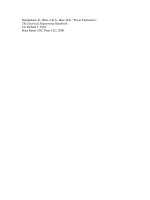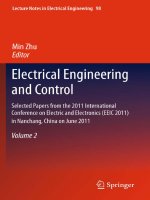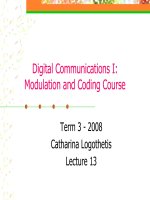Lecture Electrical Engineering: Lecture 13 - Dr. Nasim Zafar
Bạn đang xem bản rút gọn của tài liệu. Xem và tải ngay bản đầy đủ của tài liệu tại đây (1.1 MB, 37 trang )
COMSATS Institute of Information Technology
Virtual campus
Islamabad
Dr. Nasim Zafar
Electronics 1
EEE 231 – BS Electrical Engineering
Fall Semester – 2012
Bipolar Junction Transistors
Lecture No:
13
Reference:
Chapter 4 – Bipolar Junction Transistor:
Figures are redrawn (with some modifications) from
Electronic Devices
By
Thomas L. Floyd
Bipolar Junction Transistors
BJTsDevice
C
B
E
Objectives:
Ø
To study the basic structure of the Bipolar Junction Transistor
(BJT) and to determine its operating characteristics.
Ø
Ø
Ø
One of the important objective of this topic is to gain an
understanding of the mechanism of the current flow and the
transistor operation.
To analyze the properties of the transistor with proper biasing
for an Amplifier Circuit.
To relate the properties of the device to certain circuit
parameters.
BJT an Introduction:
Ø
Ø
The basis of electronic systems now a days is a semiconductor
device.
The famous and commonly used device is BJTs
(Bipolar Junction Transistors).
Ø
Invented in 1948 by Bardeen, Brattain and Shockley.
Ø
Two kinds of BPJ transistors: npn and pnp
BJT an Introduction:
Ø
A bipolar junction transistor consists of three
adjoining, alternately doped, regions of
semiconductors.
emitter : E
base: B
collector : C
BJT an Introduction:
Ø
In “normal operation” of a PNP transistor, positive voltage is
applied to the emitter and negative voltage to the collector.
Ø
Ø
A small current in the base region can be used to control a
larger current flowing between the emitter and the collector
regions.
The device can be characterized as a current amplifier, having
many applications for amplification and switching.
BJT an Introduction:
Ø
Transistors as an Amplifier for the base current, since
small changes in the base current cause big changes in the
collector current.
Ø
Transistors as a Switch: if voltage applied to the base is
such that emitterbase junction is reversebiased, no current
flows through the transistor transistor is “off”.
Ø
Transistor can be used as a VoltageControlled Switch;
computers use transistors in this way.
BJT an Introduction:
Ø
FieldEffect Transistors (FET)
–
In a pnp FET, current flowing through a thin channel of
ntype material is controlled by the voltage (electric field)
applied to two pieces of ptype material on either side of the
channel (current depends on electric field).
–
Many different kinds of FETs.
–
FETs are the kind of transistors most commonly used in
Basic Transistor Operation
&
BJT Circuits
Structure of a BJT:
Ø
BJTs are usually constructed vertically:
–
Controlling depth of the emitter’s doping sets the base
width
E
p
B
C
n
n
The structure contains two pn diodes, one between the base
and the emitter, and one between the base and the collector.
Bipolar Junction Transistors – BJTs:
The NPN and PNP BJT Transistors:
pnp
npn
E
n
p
C
n
E
p
n
C
B
C
p
C
B
B
Schematic Symbol
B
E
Schematic Symbol
E
Bipolar Junction Transistors – BJTs:
Ø
Emitter is heavily doped compared to the collector. So,
emitter and collector are not interchangeable.
Ø
The base width is narrow compared to the minority carrier
diffusion length. If the base is much larger, then the device
will behave like backtoback diodes.
Ø
Emitter doping is much higher ~ 1015
Ø
Base doping is slightly higher ~ 107 – 108
Ø
Collector doping is usually ~ 106
BJT – Circuit Symbols:
IE = IB + IC and
VEB + VBC + VCE = 0 VCE =
VEC
The currents are positive quantities when the transistor is operated
in forward active mode.
Qualitative –Transistor Action:
Consider two diodes, one forward biased and one reverse biased.
n
p
p
n
E
E
h
e e
h
e
h h
e
E
forward
e
E
h
e
h
h
e
reverse
Qualitative – Transistor Action:
Combine the two diodes!
VF
VR
h
n
p
p
h
e
I forward
h
e
I reverse
Basic Transistor Operation:
Normal operation (linear or active region):
Ø
EB junction forward biased
Basic Transistor Operation:
PNP Transistor
Ø
Ø
For a forward biased PNP emitterbase junction, the emitter
emits (injects) majority charges, holes, into the base region.
Some holes recombine with electrons in the ntype base, but
base is thin and lightly doped. Thus, most holes make it
through the base into the collector region.
Basic Transistor Operation:
PNP Transistor
Ø
This hole current is collected into negative terminal of battery;
and is called the “collector current”. The magnitude of this
collector current depends on how many holes have been
captured by electrons in the base region.
Ø
This, in turn, depends on the number of ntype carriers in the
base which can be controlled by the size of the current, the
base current, that is allowed to flow from the base to the
emitter.
Transistor Biasing Configurations
Transistor Biasing:
Ø
For the transistor to operate properly it must be biased.
Ø
There are several methods to establish the DC operating point.
Ø
We will discuss some of the methods used for biasing the
transistors.
Transistor Biasing Configurations:
1.
CommonBase Configuration (CB) :
input = VEB & IE ; output = VCB & IC
2. CommonEmitter Configuration (CE):
input = VBE & IB ; output = VCE & IC
4.
CommonCollector Configuration (CC):
input = VBC & IB ; output = VEC & IE
Transistor Biasing – Circuit Diagrams :









